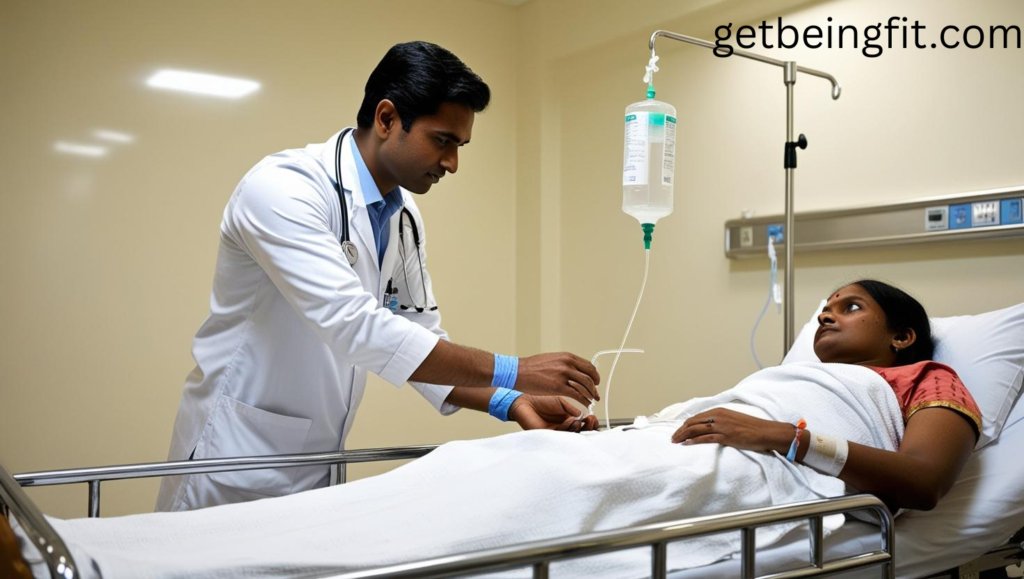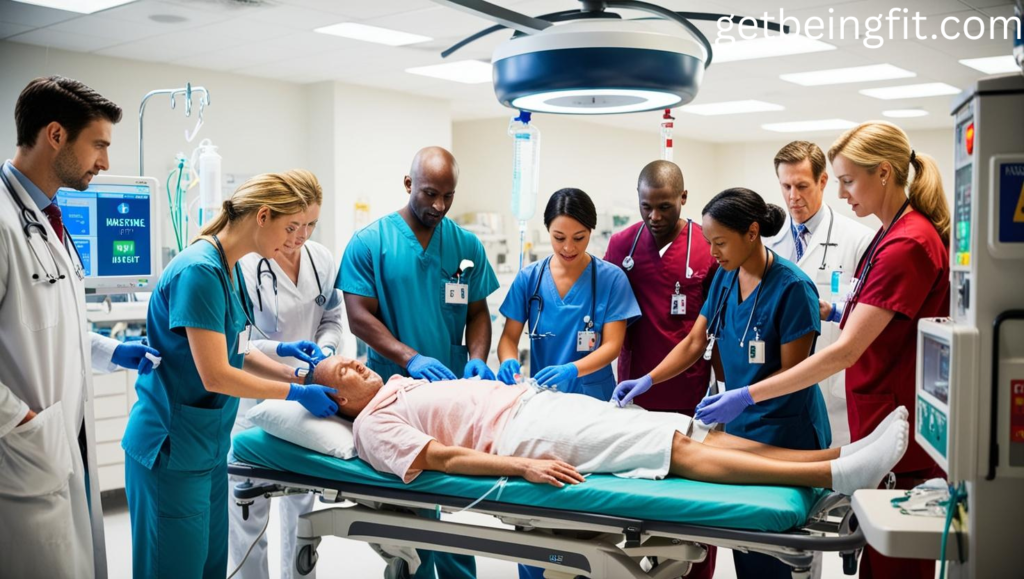As climate change accelerates, heatwaves are becoming more frequent, intense, and prolonged across the globe. Medical experts now universally agree that hospitalization must be the immediate response when individuals experience high temperature accompanied by dizziness during extreme heat events. These symptoms often signal the onset of heatstroke, a medical emergency with a mortality rate of 10-50% according to the New England Journal of Medicine.
The World Meteorological Organization (WMO) reports that the past decade has seen the hottest temperatures ever recorded, with heat-related deaths increasing by 74% globally between 1990 and 2019. This comprehensive 1,800-word guide examines:
Doctors confirm hospitalization must be immediate for high temperature and dizziness during heatwaves to prevent deadly heatstroke. Learn symptoms, risks, treatments, and prevention tips.
- The physiological mechanisms behind heatstroke
- Detailed symptom progression from heat exhaustion to heatstroke
- Evidence-based hospitalization protocols
- Cutting-edge cooling technologies in emergency medicine
- Long-term complications of heat-related illnesses
- Special considerations for vulnerable populations
- Government policies on heatwave preparedness
Heatwaves Can Kill – Know When to Seek Emergency Care!
How to Stay Hydrated During a Heatwave”
“Cold Water with Lemon: A Refreshing Health Boost”
Start your day with cold water with lemon—a simple drink packed with benefits! This natural detoxifier aids digestion, boosts immunity with vitamin C, and helps hydration. The citrus flavonoids support liver function, while the electrolytes balance hydration levels, especially crucial during heatwaves when dehydration risks rise.
CDC Heatstroke Emergency Guidelines
Introduction: The Growing Danger of Extreme Heatwaves
Climate change has led to record-breaking temperatures worldwide, making heatwaves more frequent and severe. Medical professionals emphasize that hospitalization must be a priority when individuals experience high temperature (hyperthermia) and dizziness, as these are critical signs of heatstroke—a life-threatening medical emergency.
According to the World Health Organization (WHO), heat-related illnesses have caused over 166,000 deaths globally between 1998 and 2017. The Centers for Disease Control and Prevention (CDC) reports that heatstroke leads to 600+ deaths annually in the U.S. alone. This in-depth guide explains:
- Why immediate hospitalization is crucial
- Key symptoms of heat exhaustion vs. heatstroke
- High-risk groups most vulnerable to extreme heat
- Emergency treatments and prevention strategies

Why Hospitalization Must Be Immediate for Heat-Related Illnesses
1. Heatstroke: A Deadly Condition That Requires Emergency Care
When the body’s core temperature exceeds 104°F (40°C), it can no longer regulate heat, leading to heatstroke. The National Institutes of Health (NIH) warns that without urgent medical intervention, heatstroke can cause:
- Permanent brain damage (due to swelling)
- Kidney and liver failure
- Heart attack or arrhythmia
- Death within hours
- Brain damage
- Kidney and liver failure
- Heart arrhythmias
- Death within hours
Hospitalization must include rapid cooling techniques (ice baths, cooling blankets) and IV fluid resuscitation to prevent fatal complications.
2. Severe Dehydration and Electrolyte Imbalance
Excessive sweating depletes water, sodium, and potassium, leading to:
- Confusion, seizures, or coma (hyponatremia)
- Muscle breakdown (rhabdomyolysis)
- Shock and organ failure
- 2. The 3 Stages of Heat Illness Progression
- Stage 1: Heat Cramps
- Muscle spasms in legs/abdomen
- Normal mental status
- Core temp <100.4°F (38°C)
- Stage 2: Heat Exhaustion
- Profuse sweating
- Weak, rapid pulse
- Core temp 101-103°F (38.3-39.4°C)
- Stage 3: Heatstroke (REQUIRES HOSPITALIZATION)
- No sweating (anhidrosis)
- Neurological impairment
- Core temp >104°F (40°C)

Critical Symptoms That Require Hospitalization
Doctors confirm that hospitalization must happen if any of these danger signs appear:
🔴 Life-Threatening Symptoms (Call 911 Immediately)
✔ Body temperature above 103°F (39.4°C)
✔ Severe dizziness, confusion, or hallucinations
✔ Rapid, weak pulse or breathing difficulties
✔ Hot, dry skin (no sweating – a sign of heatstroke)
✔ Fainting, seizures, or loss of consciousness
🟠 Early Warning Signs (Seek Medical Help Now)
✔ Throbbing headache and nausea
✔ Muscle cramps or weakness
✔ Excessive thirst or dark-colored urine (dehydration sign)
✔ Pale, clammy skin (indicates heat exhaustion)
Who Is Most at Risk of Heatstroke?
1. Elderly Adults (Aged 65+)
- Reduced sweat production makes temperature regulation harder.
- Chronic illnesses (heart disease, diabetes) increase vulnerability.
2. Infants and Young Children
- Higher metabolic rate leads to faster dehydration.
- Less ability to communicate symptoms.
3. Outdoor Workers (Construction, Farmers, Athletes)
- Prolonged sun exposure raises heat exhaustion risk.
- Heavy clothing or PPE traps body heat.
4. People with Chronic Medical Conditions
- High blood pressure, obesity, and respiratory diseases worsen heat sensitivity.
Internal Link: How to Protect Elderly from Heatstroke
When to Rush to the Hospital – Red Flags
🚨 Emergency Situations That Need Immediate Care
- Body temperature not dropping despite cooling efforts
- No urination for 8+ hours (severe dehydration sign)
- Unconsciousness or difficulty breathing
External Link: CDC Heatstroke Emergency Guidelines
How Hospitals Treat Severe Heatstroke
1. Rapid Cooling Methods
- Ice bath immersion (most effective for lowering temperature)
- Cooling blankets and misting fans
- IV fluids (saline solution) for rehydration
2. Medical Monitoring & Tests
- Blood tests (check for kidney/liver damage)
- ECG (electrocardiogram) for heart irregularities
- Urine analysis (for muscle breakdown detection)

How to Prevent Heatstroke Before Hospitalization is Needed
✅ Hydration is Key
- Drink water + electrolytes (ORS, sports drinks) every 15-20 minutes.
- Avoid alcohol, caffeine, and sugary drinks (they worsen dehydration).
✅ Avoid Peak Heat Hours (10 AM – 4 PM)
- Stay indoors in air-conditioned spaces.
- Use fans, cool showers, or wet towels to lower body temperature.
✅ Dress Appropriately
- Wear light-colored, loose-fitting, breathable fabrics.
- Use wide-brimmed hats and UV-protection sunglasses.
✅ Recognize Early Symptoms
- Mild dizziness, fatigue, or headache (early heat exhaustion signs)
- Muscle cramps or excessive sweating

Long-Term Health Risks of Untreated Heatstroke
Ignoring high temperature and dizziness can lead to:
- Chronic kidney disease
- Neurological damage (memory loss, coordination issues)
- Increased risk of future heat illnesses
NIH Heatstroke Treatment Guidelines
WHO Heatwave Health Risks Report
The Rising Threat of Deadly Heatwaves
With global temperatures soaring, heatwaves are becoming more frequent and intense. Medical experts warn that hospitalization must be prioritized when individuals suffer from high temperature (hyperthermia) and severe dizziness, as these are early signs of heatstroke—a life-threatening condition. According to the World Health Organization (WHO), heat-related illnesses cause over 166,000 deaths worldwide between 1998 and 2017. This comprehensive guide explains why urgent medical care is essential, who is most at risk, and how to prevent fatal heat exposure.
Conclusion: Act Fast to Save Lives
Hospitalization must never be delayed when high temperature and dizziness occur during a heatwave. Heatstroke can be fatal within hours, but early medical care saves lives. Share this guide to raise awareness and protect vulnerable groups.


